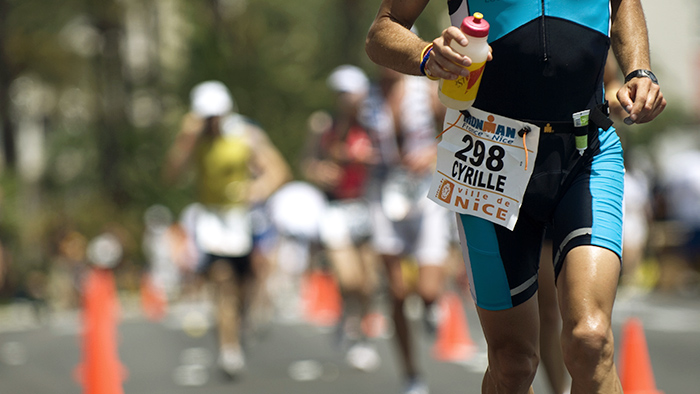Whether you’re looking to race yourself fit for a goal race, or you just have a hectic schedule and need to fit in your entire racing season in a few short weeks, many triathletes find themselves signed up for multiple races that take place within a short time period. It can be done, but your game plan for racing back-to-back triathlons needs to include a detailed periodization plan (with plenty of recovery) so you will peak at the right times.
Many moons ago, in my second year of racing the IRONMAN distance, I decided I wanted to get even fitter, faster etc. I decided to sign up for both IRONMAN Nice and IRONMAN UK in one season. They were only five weeks apart and I felt totally confident that I would PR and do well in my age group at IRONMAN UK.
After a PR at Nice, I was on track … or so I thought. IRONMAN UK was—to date—my worst performance in any race ever. It was almost as slow as my first ever IRONMAN distance race and far slower than the harder, hillier course in Nice (I’m not ashamed to admit that I basically cried my way through the last 10 miles of the run—what a waste of fluids!). Recovering enough between races is a tricky challenge, and not one to be taken lightly.
Now as a coach, I can reflect, laugh and objectively understand both sides of why I did what I did, and also recognize the learning points that I gained from this experience. My recovery strategy between each race was poor and I was on the back foot before I even started, which begs the question, “How does one race endurance events successfully back to back?”
It can’t be too hard can it? Team events like football or rugby with matches once or twice a week still allow their athletes to compete frequently and they seem to be successful through a whole season. However, even team sports follow a periodization model similar to one triathletes see with their focus being to peak for the culmination of the championship tournament or at the end of the season.
Plan Well Ahead of Time
Before you even start recovering between events, you must plan out your season (or even multiple seasons) identifying which event you want to completely peak at. This may be the finals, a world championship or your qualifier event.
Once that has been decided, you can address how you want to treat all other events throughout the season: Do you need to qualify? Is it a leg-opener? Do you want to practice nutrition for a larger event down the line?
Endurance sport pioneer Joe Friel kindly labeled these races “A,” “B” or “C” events based on how important they were to you. You can have more than one “A” race in a year, but you have to really be sure there is enough time between them to prepare for each one adequately. More importantly, after one of these “A” races, you’ll need to recover, rebuild and then re-peak.
Don’t just commit to one of them outwardly, commit internally too. Too often people state that an event is only classed as “C,” but because their training partners are also racing, the odds just changed, or maybe they don’t want to look bad in front of others, they don’t stick to their plan, race too hard and then lose focus for their “A” race.
Why Peak and Then Recover?
When you race, you are pushing your body to the limit. Things like fat percentages will be lower than they have ever been. If you don’t let them spring back, you will end up ill, injured, fatigued or fed up. Racing is exhausting for your mind and your body, a refresh will bring you back stronger and fresher. Essentially we can consider this recovery period a macro version of the Hans-Seyer model of adaptation. You have peaked, you will need to recover before you climb up to your next level of fitness.
Manage your Load
Your TrainingPeaks Performance Management Chart (PMC) will allow you to plan out these periods nicely. It will also let you identify what a manageable training load is. For someone racing IRONMAN, it may be that a 70.3 event is a manageable load – you could race them within a week of each other.
For example, if you are racing a 260 TSS bike and a 220 TSS run during your IRONMAN training, then the half IRONMAN may only create a training stress of 300 TSS in total—this is totally within your limits of fitness. The same is true for most other distances.
If your consistent training load is equivalent to the event you are racing in, then what is deemed as back-to-back could just be considered a long training day. However, notice that we are labeling these races as “just training,” not “loads of small races that I am pretending don’t mean much but actually I want to win and will kill myself trying to do so!”
Many long course athletes like doing a marathon during the early season for their running fitness. As a coach I can argue either way if it is right or wrong, but if it is not your main race, why shy away from doing a long bike ride the day before to simulate racing? Equally, remember that each triathlon distance or endurance event brings with it different physiological stresses that have to be trained for. What you have to be good at for IRONMAN racing is very different to sprint distance or standard distance racing. Where do all your events fit within the larger picture of your overall goals for the year?
Be Specific and Realistic With Your Goals
It’s amusing listening to IRONMAN athletes complain that they felt they could/should have beaten a training buddy in a 70.3 or other distance event. Why? That is like Usain Bolt complaining that he should have beaten Mo Farah over 10K because he is the fastest man on the planet! He may be, but only at the distance he is racing at. If you are racing back-to-back events, don’t have unrealistic expectations of “smashing” each race. Treat the race with the priority it deserves based on your goals. Then the recovery process becomes much easier.
Recover Right
The truth is, no matter how much pre-planning you have made, you can never fully estimate how you will fare after the event, especially if the event in question is long distance.
Therefore, between races, think what your goal of the recovery period should be, and stick to it. That being said, always listen to your body (always listen to your body more than your ego).
If you have decided to recover, don’t just smash through several hard training sessions with your friends because:
- Your race went really well and you are on a high.
- Your race went below par and you want to demonstrate to friends, training buddies, and/or yourself you don’t suck.
- You suddenly decided it is the right thing to do.
Equally, if you have decided to train straight through one race to your next event, do exactly that, put in the big overload sessions as planned. Don’t shy away from them because you are tired. You had planned to be! Stick to your annual plan.
Often doing some stock training sessions or familiar workout loops can help you compare yourself using time, speed, power as well RPE. Your local loop lets you know how well you are feeling and performing so you can gauge your fatigue and overall performance level better.
Pay Attention to Signs of Over-Fatigue or Injury
I’ll say it again—listen to your body. If you feel a niggle, address it, don’t follow the plan blindly. All aches and pains are information, and information is useful. If you keep on struggling to hit target times—take a break—maybe you are more tired than you anticipated being at this point in the year. Talk to your coach. Have you fueled correctly? If you are going to do an overload week post-event, have you been fueling properly to meet this challenge?
When you race, you put yourself out there in some capacity, even if your goal was testing nutrition or handling skills. You push harder than you would have were you not in a race. Whichever way you have raced, or whatever your goal may have been, you have achieved something in finishing a particular race and you’ve likely learned something new about yourself in the process.
Going back to my attempt to do two IRONMANS within five weeks— I recall even now the comment of a training buddy that I obviously heard but for whatever reason chose to ignore,“Are you sure you are not too tired? Normally you would have beaten me up those hills.” Remember, even bad information is good information especially if you don’t want to hear it.
Summary
At the end of the day, if you have plenty of time between events, you will want to reset and rebuild into the second event. However, if you only have a few weeks between key events, you will have to favor one—and you’ll need to make this a part of your early season planning.
The period in between two back-to-back races can literally make (or break) your season(s), so you have to pay very careful attention to both your training (quantitative) data and your own feelings (qualitative data), and make your decision based on both of them. This is where a coach or mentor becomes especially useful as an objective perspective who can keep a track of you and your ultimate “A” race.



